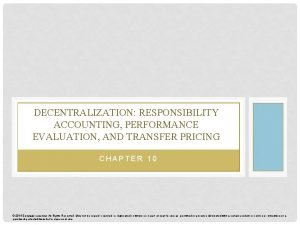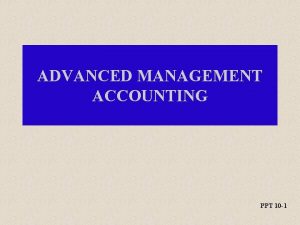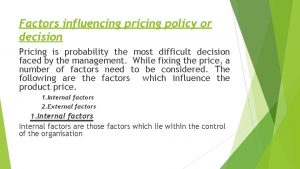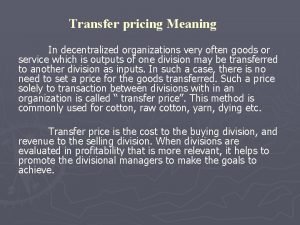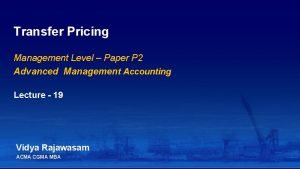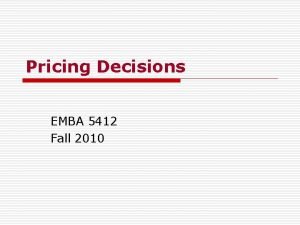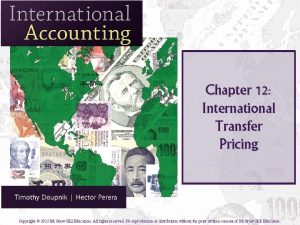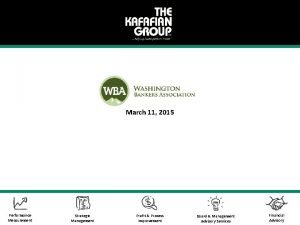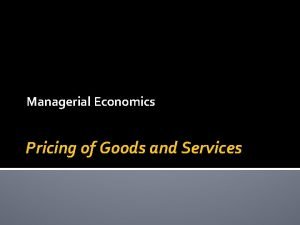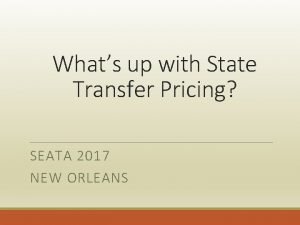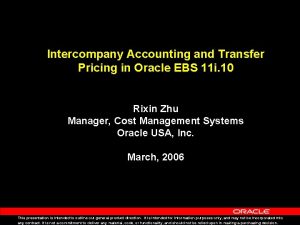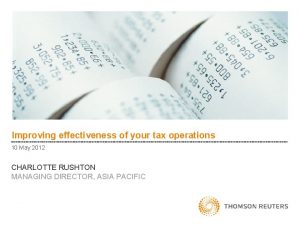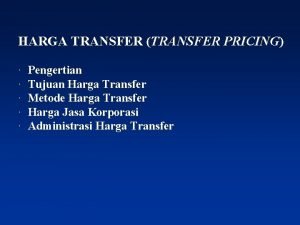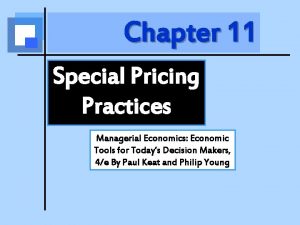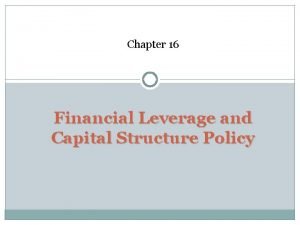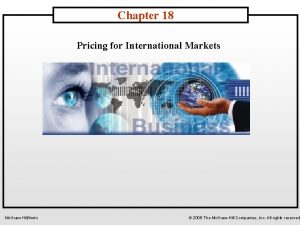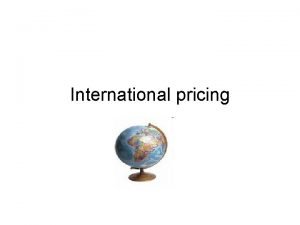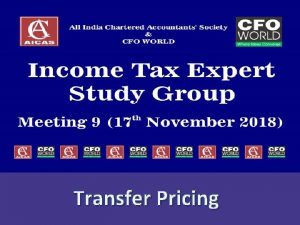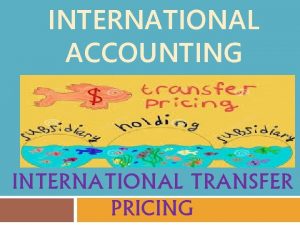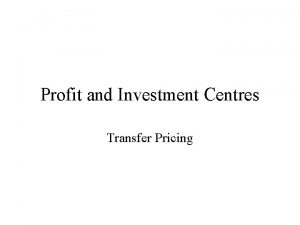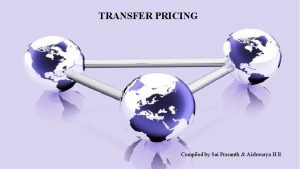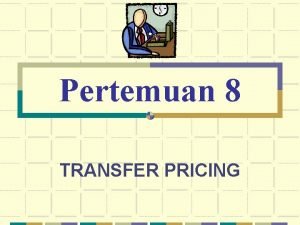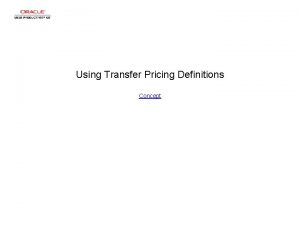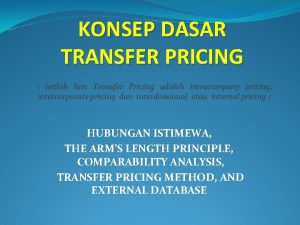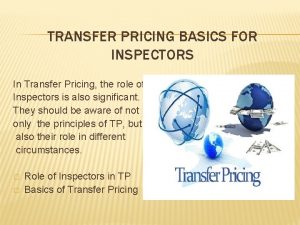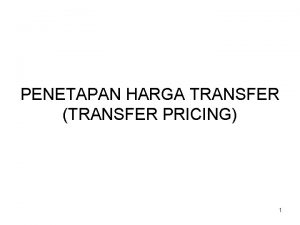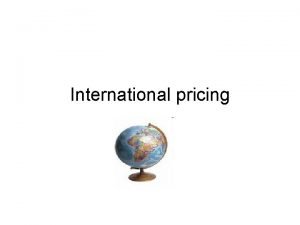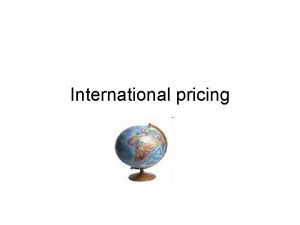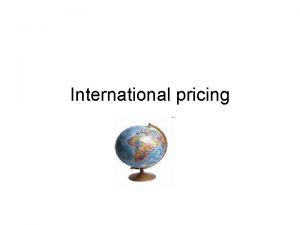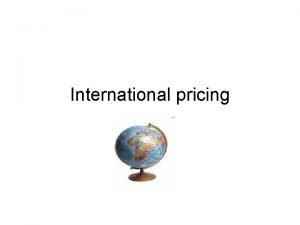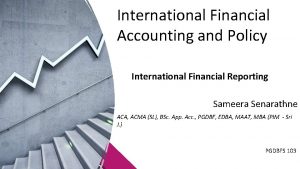International Financial Accounting and Policy International Transfer Pricing






























- Slides: 30

International Financial Accounting and Policy International Transfer Pricing Sameera Senarathne ACA, ACMA (SL), BSc. App. Acc. , PGDBF, EDBA, MAAT, MBA (PIM - Sri J. ) PGDBFS 103

Introduction • • Tax authorities investigate company’s TP policies • Certain industries & businesses that are more at risk for examination by tax authorities. Example, imports mostly scrutinized than exports, partly for political reasons & the balance of trade (imports > exports), Industries like pharmaceuticals etc. • • Price and royalty rate changes are likely to scrutiny • A domestic subsidiary of MNC that makes losses year after year (Especially, if its competitors are profitable) is likely to get more scrutiny rather single domestic company who is making losses • TP is an important tax issue faced by most of MNCs internationally. The government is especially concerned with MNCs who are not paying their fair share of taxes in the country. A survey in 2010 discovered apx. 2/3 of MNC experienced a TP audit. Apx. 1/4 of audits resulted in an adjustment by a tax authority. Penalties were imposed in almost apx. 20% cases Royalties for intangible assets, such as. brand names, mgt. service fees, R&D and interest on intercompany loans are in the radar by tax authorities

Transfer Pricing (TP) Background • TP refers to determination of the price at which transactions between related parties is carried out e. g. intercompany transactions • • Transfers between related parties referred to as intercompany transactions • • A significant proportion of international trade are intercompany transfers • TP helps to record profit accurately and to reflect its contribution to overall company profits by a division or subsidiary. • TP should motivate managers to make decisions that improve performance in a way that managers perceive as fair. TP is providing a basis for efficient allocation of resources as well ‘Upstream transfers’ - from subsidiary to parent, ‘Downstream transfers’ - from parent to subsidiary, Transfers also occurs between different subsidiaries of the same parent company ‘Revenue for the seller’ is cost for the buyer, it affects profits & performance measurement of both related parties based on the price at which a transfer is made

Decentralization and Goal Congruence • A division may be a profit center, responsible for revenue & expenses, an investment center responsible for assets, and a subsidiary for performance and position • • Top mgt. delegate or decentralize authority and responsibility to those managers • An agency problem may occur if managers make decisions in their self-interest. The manager’s self-interest may detrimental to the company • An effective accounting system can mitigate the agency problem by providing incentives and having control system to managers to act in the best interests and goals of the organization. This is called as goal congruence. These concepts are relevant to both multinational and domestic companies Decentralized companies are organized by divisions and division managers have significant authority. It allows local decision making faster. This provides more responsibility for division managers and dividing large, complex problems into manageable pieces

Objectives of International TP • Main 2 factors influencing how international TP are determined, 1. Objectives of headquarters mgt. 1. 1 Mgt. control and performance evaluation 1. 2 Cost minimization Broadly, above 2 objectives determines the appropriate price at which an intercompany transfer that cross borders is made 2. • Extent of Laws and regulations of the host country. This is to make sure that MNCs are paying their fair share of taxes, import duties while operate in multiple jurisdictions MNCs often must walk a fine line between achieving corporate objectives and complying with applicable rules and regulations in both host and home country

Performance Evaluation and TP • • • TP directly affect the profits of division or subsidiary involved in an intercompany transaction Some performance evaluation systems are based on profits generated by a division or subsidiary Effectiveness of performance evaluation system is influenced by the fairness of TP And effectiveness of performance evaluation system affects the satisfaction of managers Hence, TP should be acceptable to both parties. An acceptable price could be determined by reference to outside market prices - e. g. the price that would be paid to an outside supplier for same supply • or it could be determined by allowing the 2 parties to the transaction to negotiate a price

Cost Minimization and TP • • Profit maximization and its extension of cost minimization are important corporate objectives • The most common approach is to minimize costs by shifting profits to lower tax rate jurisdictions or arbitrarily high price, when transferring to a higher-tax country Manipulating TP between countries is one way for MNCs to achieve cost minimization. This is referred to as ‘discretionary TP’ Example Corporations have long used creative methods to shrink their tax bills or tax exposure. One of the most popular device has been to shift profits to low-tax countries. These maneuvers involve paper transactions that allow corporations to book profits on customer sales in places like no corporate income tax or low corporate income tax rates.

• Example Figures in Euro Transfer price arrangement • Yara is a parent company headquartered in the Netherlands. Yara parent is happy with this result. Because consolidated FS for them increases by Euro 2 per unit. CF will be increased when Yara Indonesia and Yara Sri Lanka remit their after-tax profits to Parent as dividends. • Yara Indonesia is also happy with this TP arrangement. Because mgt’s compensation is linked to profit. Use of discretionary TP will result in a nice bonus to them at yearend. • Unfortunately, Yara SL is unhappy with this result. Their profit is less than if they were allowed to purchase from unrelated suppliers outside. Because their profit clearly is understated, which could reflects an erroneous decision with respect to Yara SL.

Government Reactions • • • Governments are aware of risk that MNCs may use TP to avoid paying income and other taxes. • Profit Repatriation Restrictions - some countries restrict or control the profit that can be paid as a dividend back to a foreign parent company. e. g. restricted to paying a dividend equal to or less than a % of annual profit or a % of capital contributed to the company by its parent • Import Duties (Tariffs) - Countries generally assess tariffs on the value (based on invoice prices) of goods being imported into the country • Withholding Taxes - Impose certain WHT rates for dividends, interest and royalties to withheld some taxes in the country out of cross border payments made. Most governments impose TP guidelines regarding acceptable TP mechanism Guidelines are issued to establish arm’s-length price when preforming transactions. Arm’s-length price is the price that would be agreed upon by unrelated parties. i. e. Arm’s length price - the prices which would have been agreed upon between unrelated parties engaged in the same or similar transactions under the same or similar conditions in the open market

Setting Transfer Prices • Cost-based TP - Based on the cost to produce a good or service, A ‘cost-plus’ price determined as variable + fixed production cost, based on actual or budgeted/standard costs. Two problems are 1, Measure of cost to use 2. Inefficiencies in a unit may be transferred to other. Hence, Cost based methods of determining TP are preferred when the following variables are important. Differences in income tax rates, Minimization of import duties, Foreign exchange controls and risks, Restrictions on profit repatriation, Risk of expropriation and nationalization. • Market-based TP - Price based on unrelated customer or determined by reference to similar products or services by unrelated parties. This avoids transferring the inefficiencies of division/subsidiary to others, Good basis for evaluating performance too. Efficient working depends on the existence of competitive markets. Sometimes, there may not be any buyers outside the entity or no external market price. Market-based methods of determining TP are preferred when consider interests of local partners i. e. local partners find market-based methods to be more fair and objective and these methods also are easier to defend in disputes with the government. • Negotiated price - Negotiation between buyer and seller and may be unrelated to either cost or market value. Some problems faced here is that negotiation can take a long time & dependency on ability to negotiate.

OECD Guidelines for TP • TP guidelines were issued by Organization for Economic Cooperation and Development (OECD) to avoid conflicts among member countries • OECD rules are only a model and do not have the force of law in any country. However, most countries have TP rules generally based on OECD guidelines with some variations • Basic rule is that transfers must be made at arm's-length prices, i. e. prices that would be charged between independent parties in the same circumstances • Guide the need for documentation of the arm's-length nature OECD Country-by-Country Reporting (Cb. C) • Help tax authorities to identify companies who may have the capability of shifting profit to a low or no-tax jurisdiction • Assist tax authorities in targeting their audits and cases against MNCs involved in profit shifting • Requires an MNE to annually file a Cb. C Report with its home taxing authority that discloses, for each jurisdiction in which it conducts business. Such as, Revenue, PBT, income tax paid, no of employees, capital, and tangible assets etc.

US TP Rules Understanding US TP rules is important due to, • TP reforms that took place in US have influenced changes in TP regulation in many other countries • • Most MNCs are from USA or have significant business activities US Internal Revenue Code gives Internal Revenue Service (IRS) the authority to audit international TP and adjust a company's tax liability if the price is deemed to be inappropriate. Audit and adjust TP between companies controlled directly or indirectly. This covers, ü Transfers between a US parent & its foreign subsidiary ü Between a foreign parent and its US subsidiary ü Between US subsidiary and foreign subsidiary of the same parent • Similar to OECD guidelines, it requires transactions between commonly controlled entities to be carried out at arms-length prices. If do not exist, it will involve reference to comparable transactions under comparable circumstances

Glossary of terms Uncontrolled transaction: A transaction that takes place between independent enterprises (or unrelated entities/parties) Controlled transaction: A transaction that takes place between associated enterprises (or related entities/parties) Associated enterprises (AEs): 2 or more enterprises that participate, directly or indirectly, in the mgt. , control or capital of the others Independent enterprises (IEs): 2 or more enterprises that are not associated enterprises.

• Determining methods for Arm's-length price In determining method for an Arm's-length price, primarily two factors can be considered, 1. The degree of comparability between the intercompany transaction and any comparable uncontrolled transactions. Determining the degree of comparability between an intercompany transaction and an uncontrolled transaction involves a comparison of the below five factors, i. Functions performed ii. Contractual terms iii. Risks that could affect the prices iv. Economic conditions v. Property or services transferred 2. The quality of the data and assumptions used in the analysis

Sale of Tangible and Intangible : Arm's-length TP regulation requires to use one of below method to determine the arms length price in a sale of tangible property (Inventory, Fixed assets etc. ) or Intangible property (Licensed intangibles etc. ) § § § Comparable Uncontrolled Price/Transaction Method -Tangible property : CUP / Intangible - CUT Resale price method - For Tangible property Cost-plus method - For Tangible property Comparable profits method - For both Tangible/Intangible property Profit split method - For both Tangible/Intangible property Unspecified method (For both Tangible/Intangible property) - If none of above methods is determined to be appropriate, a firm is allowed to use an unspecified method, provided it can be justified The comparable profits method and profit split method are the same methods as those available for establishing TP for both tangible and Intangible property CUP method available for tangible property is similar in concept to the CUT method for intangible property

Comparable Uncontrolled Price method (CUP) • Popular and reliable measure to determine the arms’ length price when a comparable uncontrolled transaction exists for tangible property TP Example : Netherland-based parent company (Yara NL) makes sales of tangible property to a foreign subsidiary (Yara SL). Under this method, the price for tax purposes is determined by reference to sales by Yara NL of the same or similar product to unrelated customers or purchases by Yara SLK of the same or similar product from unrelated suppliers. Also, sales of the same product between two unrelated parties could be used to determine the TP. • ‘Price’ is determined comparing similar products and surrounding conditions : TP is determined reference to the company’s sales of the same product to an unrelated buyer. i. e. reference to transactions between two unrelated parties for the same product are acceptable. • Factors relevant in determining whether an uncontrolled transaction is comparable: Quality of the product, Contractual terms, Level of the market, Geographic market, Date of the transaction, Intangible property associated with the sale, Foreign currency risks, Alternatives realistically available to the buyer and seller etc. Sometimes, uncontrolled transactions do not exactly comparable

Comparable Uncontrolled Price method (CUP) Situation 2 Situation 1 Yara NL Parent company TP Yara SL Subsidiary company Outside Sri Lanka Internal cup Unrelated company X Unrelated company Y Outside Sri Lanka External cup Sri Lanka Unrelated company Z Sri Lanka

Comparable uncontrolled transaction method (CUT) • • A method using to determine arm’s length transactions for intangible property Determines whether or not the amount a company charges a related party for the use of intangible property is an arm’s-length price by referring to the amount it charges an unrelated party for the use of the intangible Example : CUT method used in US, determines an arm's length royalty rate for an intangible by reference to uncontrolled transfers of comparable intangible property under comparable circumstances Categories of intangible property: • Patents, Designs, Know-how • Copyrights • Trademarks, Trade names, or Brand names • Franchises, Licenses or Contracts • Methods, Programs, Systems, Procedures, Campaigns, Customer lists or Technical data • Other similar items. An item is considered similar if it derives its value from its intellectual content

Resale Price Method (RPM) • RPM determines the TP by subtracting an appropriate GP from the price at which the controlled buyer resells the tangible property • In order to use this method, a company must know the final selling price to uncontrolled parties and be able to determine an appropriate GP for the reseller • An appropriate GP is determined by reference to the GP margin earned in comparable uncontrolled transactions Example: Netherland Company ‘NL’ manufactures and sells vehicle batteries to affiliate company ‘SL’ in Sri Lanka, which in turn sells the batteries to local retailers at a resale price of LKR 5, 000 per unit. Other non affiliate/3 rd party Sri Lanka distributors of batteries earn an average gross profit margin of 25% on similar sales. When apply the RPM, NL would establish an arm’s length price of LKR 3, 750 per unit for sale of batteries to SL (resale price of LKR 5, 000 less an appropriate gross profit of LKR 1, 250 (25%) to be earned by SL. • GP/Sales comparing with entities engaged in distribution of products. This method is acceptable when the buyer does not add a substantial value to the product

Resale Price Method (RPM) E. g. Netherland company who is foreign manufacturer has its affiliate distributor in Sri Lanka to sell product A Netherland Foreign Manufacturer Product A Sri Lanka Associated Distributor (AE) Resale price is 600 End consumer in Sri Lanka Product B A 3 rd party Distributor (Appointed) COGS 350 Sales 500 End consumer in Sri Lanka GP margin is 30% Meantime foreign manufacturer has also appointed 3 rd party distributor for product B in Sri Lanka GP margin of 3 rd party distributor from sale of product B is 30% Market price of product A in Sri Lanka 600 Transfer price for sale of product A by the foreign manufacturer to its associate enterprise in Sri Lanka is 420 resale price * (1 -30%) = 420 600 * 70% = 420

Cost-Plus Method • Cost-Plus Method is most appropriate when there are no comparable uncontrolled sales and the related buyer does more than simply distribute the goods it purchases • • It adds an appropriate GP to cost of producing a product to establish an arm's-length price • Physical similarity between the products transferred is not as important in determining comparability Cost-Plus Method normally used involving manufacturing, assembly or other production of goods that are sold to related parties. GP is determined by reference to uncontrolled parties Example : NL Co. has a subsidiary in SLK that acquires materials locally to produce an electronic Component. It costs LKR 4, 000 per unit to produce, is sold only to NL Co. and does not sell to other unrelated parties. NL Co. combines the electronic component imported from SLK with other parts to assemble electronic switches that are sold to Germany. i. e. NL does not simply resell as it is. Therefore, NL must look for a comparable transaction between unrelated parties in SLK to determine whether the Cost-Plus Method can be used. Assume comparable Co. in SLK manufactures similar electronic components and sells to unrelated buyers at an average GP markup on cost of 25%. In this case, application of the Cost-Plus Method results in a TP of LKR 5, 000 [LKR 4, 000 + (LKR 4, 000 x 25%)] for the electronic component that NL purchases from its SLK subsidiary

Cost-Plus Method E. g. - Foreign manufacturer (France) has a subsidiary in Sri Lanka, Sri Lanka manufactures and supply semi finished goods to its foreign AE in France. - Comparable companies in Sri Lanka selling similar products earn an average mark-up on cost of 20% France Parent Company, Foreign AE 3 rd party buyer Supply of semi FG Price = cost + mark-up? Price = cost + 20 % Sri Lanka, Manufacturer (AE) Sri Lanka, Manufacturer 3 rd party Cost of RM 2, 000 Other direct and indirect production costs 1, 000 Total cost base 3, 000 Mark-up on costs (20% tested in CPM 600 Determined from uncontrolled comparable_ Therefore, TP is 3, 600 Mark-up on costs OH & Other operating expenses Operating profit 600 (400) 200

Comparable profits method • This method is based on the assumption that similarly situated taxpayers will tend to earn similar returns over a given period. Under this method, one of the 2 parties in a related transaction is chosen for examination • An arm’s-length price is determined by referring to an objective measure of profitability earned by uncontrolled taxpayers on comparable, uncontrolled sales • Profit indicators that might be considered in applying this method include the ratio of operating income to operating assets, the ratio of GP to operating expenses, or the ratio of OP to sales • If TP used results in ratios for the party being examined that are in line with those ratios for similar businesses, then the TP will not be challenged Example : NL is a Netherland manufacturer, distributes its products in Sri Lanka through its foreign sales subsidiary -SL. SL has sales of LKR 1, 000 Mn and operating expenses (other than COGS) of Euro 200 Mn. Over the past several years, comparable distributors in Sri Lanka have earned OP equal to 5% of sales. Under this method, a TP that provides SL an OP equal to 5% of sales would be considered arm's length. An acceptable OP for SL is LKR 50 Mn (LKR 1, 000 Mn x 5%). to To achieve this OP, re-calculated COGS must be LKR 750 Mn (LKR 1, 000 Mn - LKR 200 Mn - LKR 50 Mn). This is the amount that NL would be allowed to charge as a TP for its sales to SL. This example demonstrates use of the ratio of OP to sales as the profit-level indicator under this method. The regulations also specifically mention use of the ratio of OP to operating assets and the ratio of GP operating expenses as acceptable profit-level indicators in applying this method.

Profit Split Method (PSM) • This method assumes that the buyer and seller are one economic unit. The total profit earned by the economic unit from sales to uncontrolled parties is allocated to the members of the economic unit based on their relative contributions in earning the profit • The relative value of each party's contribution in earning the profit is based on the functions performed, risks assumed and resources employed in the business that generates the profit Example : Assume pharmaceutical company has a manufacturing affiliate help with R&D to bring a new drug. The two related parties need to determine the right profit split to include in pharmaceutical agreement. They will use the contribution PSM to ensure they divide the drug profits fairly. It’s necessary to determine the contributions made by both parties for R&D, marketing, and other necessary expenses. The 2 parties invested a $500 Mn, R&D company contributed $375 Mn. Because $375 Mn is 75%, R&D company will make 75% of future profits, with the drug manufacturer collecting the remaining 25%. Not widely applied and always the “last resort” method

Arm's-Length Range • • TP method can result in a range of TP and company’s discretion to set prices within the range • A company will not be subject to Tax authority adjustment as long as its TP falls within this range. The Tax authority acknowledges that application of a specific TP method could result in a number of TP, thereby creating an ‘arm’s-length range’ of prices. Example: Assume that US Company determines the comparable uncontrolled price method to be the "best method'' for purchases of Product X from its wholly-owned Sri Lanka subsidiary. Four comparable uncontrolled transactions are identified with prices of $9. 50, $9. 75, $10. 00, and $10. 50. US Company can purchase Product X from its Sri Lanka subsidiary at a price anywhere from $9. 50 to $ 10. 50 without the risk of an adjustment being made by the tax authority. The company may wish to choose that price within the arm’s length range (either the highest price or the lowest price) that would allow it to achieve one or more cost-minimization objectives.

• Other Intercompany Transactions Intercompany Loans : When an intercompany of a group company issue a loan to another intercompany in the group - an arm’s length rate of interest to be charged on the loan. Factors to be considered when determining an arm's-length interest rate • • Principal & Duration of the loan Security involved Credit standing of the borrower and Interest rate prevailing for comparable loans between unrelated parties Example, if US manufacturing firm made a USD loan to its foreign subsidiary, interest rate is considered to be at arm's length if it is at a rate not less than the applicable federal rate (AFR) and not greater than interest range specified in the regulation (e. g. 130%) of the AFR. The AFR is based on the average interest rate on obligations of the federal government with similar maturity dates. Assume the AFR is recomputed each month and an AFR of 4% on 1 year obligations, US manufacturing firm could charge an interest rate anywhere from 4% to 5. 2% on a 1 year USD loan to its foreign subsidiary without having to worry about a TP adjustment being made by the IRS in US

Other Intercompany Transactions • Intercompany Services : When an intercompany of a group company provides a service to another intercompany of the group, the purchaser must pay an arm's-length price to the service provider. • If the services provided are incidental to the business activities of the service provider, the arm'slength price is equal to the direct and indirect costs incurred in connection with providing the service. Example, Assume that engineers employed by US Company travel to the Germany to provide technical assistance to the company’s Germany subsidiary in setting up a production facility. US company must charge the Germany foreign subsidiary a fee for this service equal to the direct and indirect costs incurred. Direct costs include the cost of the engineers’ travel to Germany and their salaries while on the assignment. Indirect costs might include a portion of US company's overhead costs allocated to the engineering department. If US company is in the business of providing this type of service to unrelated parties, it must also include an appropriate amount of profit in the technical assistance fee it charges its Germany subsidiary

Penalties Compliance with TP Apart from the powers to adjust TP, tax authority has the authority to impose penalties on companies that failed to comply TP regulation or significantly underpay taxes as a result of inappropriate TP. A penalty equal to % of the underpayment in taxes may be levied for a substantial valuation misstatement. The amount and % of penalty is varied based on the country regulation and different to each other. Documentation Taxpayers must maintain a proper TP documentation which can justify the TP method selected TP method should be a reliable measure of arm's-length price in the business context The company should be able to provide TP documentation to tax authority within stipulated timeline as per country’s TP regulation requirements of its being requested. Countries have established documentation rules to state clearly with relevant supporting evidence as to how their TP policies comply with the arm's-length requirements. Many jurisdictions have implemented strict penalty regimes to encourage taxpayers compliance with TP documentation requirements.

Reporting Compliance with TP To determine whether intercompany transactions meet the arms-length price requirement, most of the countries TP regulations now requires substantial reporting and record keeping of the company. Country-by-Country Reporting (Cb. C) Certain countries including US require annual Cb. C reports to be filed by companies along with their annual income tax return with the tax authority. This regulations are based on the template developed by the OECD and they must be followed by the ultimate parent entity of an MNE group that has annual revenue of exceeding the limit specified in the regulation. Advance pricing agreements (APAs) US originated and actively promotes the use of APAs. An APA is an agreement between a company and the tax authority to apply an agreed-on TP method to specified transactions. The Tax authority agrees not to seek any TP adjustments for transactions covered by APA if the company uses the agreed-on method.

Thank you!
 Types of responsibility accounting
Types of responsibility accounting Intermediate accounting chapter 1
Intermediate accounting chapter 1 Social responsibility accounting ppt
Social responsibility accounting ppt Advanced cost and management accounting ppt
Advanced cost and management accounting ppt Global pricing policy
Global pricing policy Factors influencing international pricing
Factors influencing international pricing Transfer pricing methods with examples
Transfer pricing methods with examples Transfer pricing example
Transfer pricing example Transfer pricing examples
Transfer pricing examples Transfer pricing example
Transfer pricing example Importance of transfer pricing
Importance of transfer pricing Roe vs roi
Roe vs roi Transfer pricing in managerial economics
Transfer pricing in managerial economics Multi-state transfer pricing analysis
Multi-state transfer pricing analysis Intercompany accounting entries in oracle r12
Intercompany accounting entries in oracle r12 Guidance on transfer pricing aspects of intangibles
Guidance on transfer pricing aspects of intangibles Transfer pricing
Transfer pricing Global transfer pricing survey
Global transfer pricing survey Wu transfer pricing center
Wu transfer pricing center Pengertian transfer pricing
Pengertian transfer pricing Pricing practices in managerial economics
Pricing practices in managerial economics Financial leverage and capital structure policy
Financial leverage and capital structure policy Capital structure leverage
Capital structure leverage Corporate financial policy and the value of cash
Corporate financial policy and the value of cash A wave is a disturbance that transfers energy
A wave is a disturbance that transfers energy Financial and non financial methods of motivation
Financial and non financial methods of motivation Pricing for international markets
Pricing for international markets International pricing process
International pricing process International pricing strategies
International pricing strategies International pricing objectives
International pricing objectives 4 international business strategies
4 international business strategies
